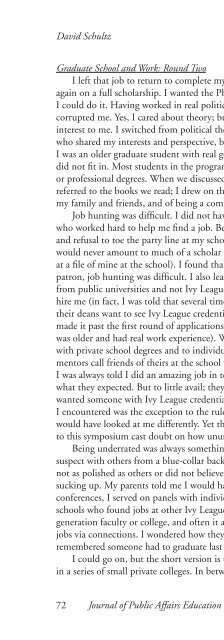WINTER 2012 - National Association of Schools of Public Affairs and ...
WINTER 2012 - National Association of Schools of Public Affairs and ...
WINTER 2012 - National Association of Schools of Public Affairs and ...
Create successful ePaper yourself
Turn your PDF publications into a flip-book with our unique Google optimized e-Paper software.
Bin Chen, Feng Wang <strong>and</strong> Jianmin Song<br />
to 2.5 classmates for seeking career-related information <strong>and</strong> advice <strong>and</strong> shared<br />
the information <strong>and</strong> advice with 2.5 classmates. 3 Across the four networks, the<br />
academic network had the highest out-degree <strong>and</strong> in-degree centrality scores<br />
(5.9), the friendship network scored the second highest (4.8), <strong>and</strong> career advice<br />
network scored third (2.5). The socio-emotional support network had the<br />
lowest scores on out- <strong>and</strong> in-degree measures. The results are consistent with our<br />
visual observation that the academic <strong>and</strong> friendship networks are much more<br />
connected than the career advice <strong>and</strong> socio-emotional support networks.<br />
We observed similar patterns across the four networks in terms <strong>of</strong> closeness<br />
centrality <strong>and</strong> betweenness centrality. Closeness centrality is a measure <strong>of</strong> how<br />
centrally close a person is, meaning that he or she can reach all others more<br />
quickly. An individual with a higher closeness centrality score is usually<br />
considered as an information disseminator. On average, MPA students in the<br />
academic <strong>and</strong> friendship networks are able to reach other students more quickly<br />
than can those in the career advice <strong>and</strong> socio-emotional support networks.<br />
Betweenness centrality refers to the degree that a person lies between the paths<br />
connecting other persons. Individuals with high betweenness centrality scores<br />
are in a good position to function as gatekeepers or brokers. In a similar vein,<br />
on average, MPA students in the academic <strong>and</strong> friendship networks have more<br />
chances to play the intermediary role <strong>of</strong> gatekeepers or brokers.<br />
Existing literature <strong>of</strong>fers two reasons to explain why MPA students’ career<br />
advice <strong>and</strong> socio-emotional support networks are much sparser than their<br />
academic <strong>and</strong> friendship networks. First, it usually takes more time to develop<br />
more personal interactions such as sharing career advice, sharing information,<br />
<strong>and</strong> seeking emotional comfort. Interpersonal interactions <strong>of</strong> this nature will not<br />
occur until a high level <strong>of</strong> trust can be cultivated after many other interactions<br />
are conducted at arms’ length (Sias & Cahill, 1998). Second, the weakest<br />
connectedness in the socio-emotional support network is consistent with other<br />
empirical findings that social <strong>and</strong> emotional support is the most difficult to find<br />
in Chinese society. A study <strong>of</strong> personal support network in Beijing concludes<br />
that Chinese are more likely to seek socio-emotional support from close family<br />
members <strong>and</strong> coworkers (Lee, Ruan, & Lai, 2005).<br />
Our findings on Chinese MPA academic <strong>and</strong> social networks also contrast<br />
with the findings for undergraduate students in the United States, who usually<br />
find social ties to be more numerous than academic ties (Smith, 2010). We<br />
expect this due to the nature <strong>of</strong> a pr<strong>of</strong>essional graduate degree program. All the<br />
students in our study are commuting in-service pr<strong>of</strong>essionals <strong>and</strong> studying parttime,<br />
while undergraduate students living in a residential campus have many<br />
more chances to establish extensive social ties.<br />
Whole Network Measures<br />
At the network level, we examined three structural properties <strong>of</strong> interaction<br />
patterns in MPA students’ academic <strong>and</strong> social networks: network centralization,<br />
148 Journal <strong>of</strong> <strong>Public</strong> <strong>Affairs</strong> Education

















